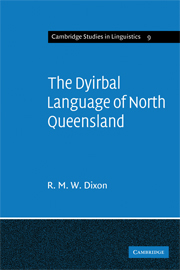Book contents
- Frontmatter
- Contents
- List of maps and plates
- Acknowledgements
- Preface
- Abbreviations and conventions
- 1 AUSTRALIAN LANGUAGES
- 2 DYIRBAL: THE LANGUAGE AND ITS SPEAKERS
- 3 WORD CLASSES
- 4 SYNTAX
- 5 DEEP SYNTAX
- 6 MORPHOLOGY
- 7 PHONOLOGY
- 8 SEMANTICS
- 9 LEXICON
- 10 PREHISTORY
- APPENDIX A DYIRBAL LOGIC
- APPENDIX B PREVIOUS WORK ON DYIRBAL
- TEXTS
- VOCABULARY
- LIST OF DYIRBAL AFFIXES
- REFERENCES
- INDEX OF AUSTRALIAN LANGUAGES
- Plate section
- Frontmatter
- Contents
- List of maps and plates
- Acknowledgements
- Preface
- Abbreviations and conventions
- 1 AUSTRALIAN LANGUAGES
- 2 DYIRBAL: THE LANGUAGE AND ITS SPEAKERS
- 3 WORD CLASSES
- 4 SYNTAX
- 5 DEEP SYNTAX
- 6 MORPHOLOGY
- 7 PHONOLOGY
- 8 SEMANTICS
- 9 LEXICON
- 10 PREHISTORY
- APPENDIX A DYIRBAL LOGIC
- APPENDIX B PREVIOUS WORK ON DYIRBAL
- TEXTS
- VOCABULARY
- LIST OF DYIRBAL AFFIXES
- REFERENCES
- INDEX OF AUSTRALIAN LANGUAGES
- Plate section
Summary
This chapter attempts to do two things. Firstly, to examine lexical and grammatical relationships between the dialects of Dyirbal and surrounding dialects in an attempt to assess the genetic relationships of the dialects and to reconstruct past tribal movement. Secondly, to assess ways in which individual dialects of Dyirbal differ from the general pattern of the language, with a view to internal reconstruction of some aspects of past stages of Dyirbal.
As mentioned in 1.1, it seems likely that most Australian languages (certainly, all those outside Arnhem Land and the Barkly Tableland) are genetically related; we can call this a ‘weak genetic relation’. In this chapter we are interested in whether a pair of languages are ‘strongly genetically related’ – that is, whether they can be related to a common ancestor that is considerably less ancient than proto-Australian. If two languages belong to the same ‘branch’ or ‘subgroup’ of a family then they are said to be ‘strongly related’; if they are members of different branches then they are ‘weakly related’. Consider an Indo-European analogy: Welsh is strongly related to Breton and Cornish, and (slightly less strongly) to Irish, within the Celtic branch of Indo-European; it is only weakly related to languages such as Lithuanian, English and Greek.
In the discussion below we will use ‘genetic relationship’ to mean ‘strong genetic relationship’. Thus we conclude that Dyirbal and Yidin, the language next to the north, are probably not genetically related; that is, to connect them on the ‘family tree’ of Australian languages one would probably have to pass through proto-Australian, at the apex.
- Type
- Chapter
- Information
- The Dyirbal Language of North Queensland , pp. 330 - 360Publisher: Cambridge University PressPrint publication year: 1972



